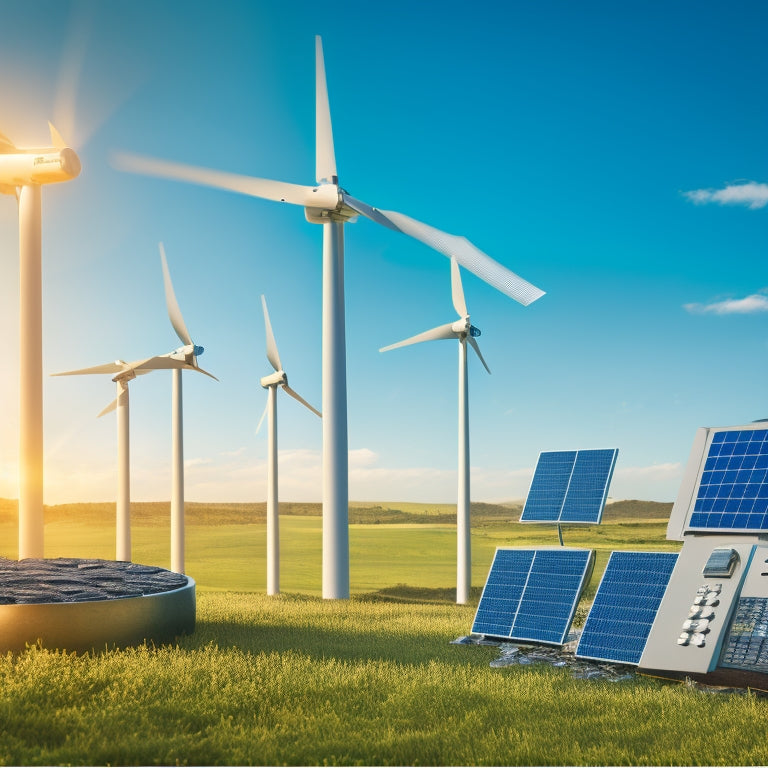
Calculate Your Clean Energy Investment's Real Returns
Share
You can calculate the real returns on your clean energy investment by evaluating key performance metrics, such as energy savings, carbon footprint reduction, and ROI. Consider factors like peak performance metrics, such as energy efficiency ratios and capacity factors, to assess system performance. Analyze your energy expenditure, identifying high-energy usage areas and evaluating opportunities for optimization. Assess your current carbon footprint, including energy consumption, transportation, and waste. By examining these metrics, you'll gain a clear understanding of your investment's real returns, and a closer look at the data will reveal even more opportunities to maximize your benefits.
Key Takeaways
- Calculate the Levelized Cost of Energy (LCOE) to determine the cost-benefit ratio of your clean energy investment.
- Assess the Capacity Factor of your system to evaluate its ability to generate maximum potential energy.
- Consider government incentives, such as tax credits, to enhance the affordability of your clean energy investment.
- Evaluate the potential annual savings on utility bills and emissions reductions to justify your investment.
- Utilize performance metrics like Energy Efficiency Ratio (EER) and Coefficient of Performance (COP) to optimize your system's performance.
Understanding Your Energy Expenditure
You're likely no stranger to the concept of energy expenditure, but understanding precisely where your energy dollars are going can be a complex task. To gain control over your energy consumption, start by analyzing your utility bills to identify areas of high energy usage.
Take a closer look at your household appliances and their energy habits. Are there opportunities for lifestyle changes, such as adjusting your thermostat or using energy-efficient light bulbs?
Consider seasonal variations in your energy consumption and adjust your energy budgeting accordingly. With the increasing adoption of electric vehicles, home charging installation can also play a significant role in reducing energy expenditure.
Additionally, understanding the total cost of ownership, including fuel and maintenance costs, can help you make informed decisions about your energy investments. Smart meters can provide significant observations into your energy habits, helping you make data-driven decisions to optimize your energy expenditure.
Assessing Your Current Carbon Footprint
As you've taken the first step in understanding your energy expenditure, it's now time to examine the environmental impact of your daily habits. Conducting a carbon footprint assessment helps you quantify the lifestyle impact of your daily choices.
You'll need to calculate your emissions from energy consumption, transportation, food production, and waste management. Online carbon calculators can guide you through this process, considering factors like your location, diet, and transportation methods.
Did you know that switching to electric vehicles can greatly reduce your carbon footprint, as they produce zero tailpipe emissions and lower operating costs? Additionally, with over 1,200 public charging stations available in Pennsylvania, making the switch is more convenient than ever.
Be prepared to gather data on your energy bills, mileage, and waste generation. By doing so, you'll gain a clear understanding of your current carbon footprint, enabling you to identify areas for improvement and make informed decisions about your clean energy investments.
Calculating Solar Panel ROI
Calculating Solar Panel ROI
You're considering investing in solar panels to reduce your carbon footprint and gain energy independence. To determine the return on investment (ROI), you'll need to calculate the total savings over the solar panel lifespan, typically 25-30 years.
Start by factoring in installation costs, financing options, and maintenance requirements. Then, consider government incentives, such as tax credits, and performance degradation rates.
Additionally, integrating solar panels into your trucking operations can lead to reduced fuel consumption costs and extended battery lifespan, further increasing your ROI.
Next, estimate the energy output and resulting savings on your utility bills. Don't forget to include tax benefits and potential resale value.
Measuring Electric Vehicle Savings
You'll want to quantify the financial benefits of switching to an electric vehicle (EV), starting with fuel cost reduction.
By comparing your EV's electricity costs to what you'd spend on gasoline, you can calculate the annual savings. In fact, EVs offer substantial annual cost savings, ranging from $400 to $1,200 refueling cost comparison.
Additionally, you'll also want to assess the emissions savings, measured in tons of CO2 equivalent, to further justify your investment in clean energy.
Fuel Cost Reduction
Electric vehicles (EVs) revolutionize your daily commute by slashing fuel costs, a significant advantage over traditional internal combustion engine vehicles. By switching to an EV, you can break free from the volatility of fossil fuel prices and reap the benefits of alternative fuels.
With over 150 EV models available, you can find one that fits your budget and lifestyle Diverse EV model options. Additionally, federal tax credits and incentives can enhance the affordability of clean energy vehicle adoption.
Here's how you can calculate your fuel cost reduction:
-
Long-term savings: EVs can save you up to $1,000 annually on fuel costs, depending on your driving habits and local energy prices.
-
Energy independence: By utilizing electricity from utility partnerships, you can reduce your reliance on imported fuels and contribute to a more sustainable energy future.
-
Government incentives: Take advantage of government incentives and financing options to offset the higher upfront cost of EVs.
-
Technological advancements: Ongoing innovations in EV technology continue to improve efficiency and reduce operating costs.
-
Market trends: As the demand for EVs grows, market trends indicate a decrease in battery costs, making EVs an increasingly viable option for environmentally conscious consumers.
Emissions Savings
As the transportation sector continues to be a significant contributor to greenhouse gas emissions, switching to electric vehicles (EVs) offers a substantial opportunity to reduce your carbon footprint.
By making the switch, you can calculate your emissions reduction and monetize it through carbon offsets. According to the US Environmental Protection Agency, EVs produce zero tailpipe emissions, which translates to a significant decrease in greenhouse gas emissions per mile compared to traditional gas-powered vehicles.
Home Energy Generation Monitoring
Several homeowners who invest in clean energy solutions, such as solar panels or wind turbines, are keenly interested in monitoring their home energy generation.
This allows them to track their progress toward energy independence and make data-driven decisions to enhance their system's performance.
With energy monitoring tools, you can:
- Access real-time analytics to track your energy production and consumption
- Compare your system's performance to performance benchmarks for peak efficiency
- Identify usage patterns and adjust your habits to reduce waste
- Receive system alerts when maintenance is required or performance drops
- Visualize your consumption trends through intuitive data visualization tools
Optimizing Your Energy Efficiency
You're likely to maximize your clean energy investment returns by identifying areas of inefficiency in your system.
To do this, you'll need to conduct an energy audit, leveraging essential tools to pinpoint opportunities for improvement.
Energy Audit Essentials
How efficiently is your building or facility using energy? Conducting an energy audit is vital to identifying areas of improvement and revealing energy audit benefits. The audit process involves a thorough examination of your energy consumption patterns, helping you pinpoint opportunities to optimize energy usage.
Some essential aspects of an energy audit include:
- Reviewing your energy bills and consumption data
- Conducting on-site inspections to identify energy-wasting areas
- Analyzing energy usage patterns to identify opportunities for improvement
- Providing recommendations for energy-efficient upgrades and retrofits
- Offering guidance on implementing energy-saving strategies and practices
System Optimization Tools
Conducting an energy audit sets the stage for optimizing your energy efficiency. Now, it's time to employ system optimization tools to fine-tune your clean energy investment. These tools help you identify areas for improvement, streamline energy management, and enhance system performance.
| Tool | Function |
|---|---|
| Energy Management Software | Monitors and controls energy usage, providing real-time data for informed decisions |
| Performance Analytics | Analyzes system data to identify trends, inefficiencies, and opportunities for improvement |
| Optimization Algorithms | Applies complex calculations to optimize system performance, reducing energy waste and costs |
| Simulation Modeling | Simulates different scenarios to predict energy savings and returns on investment |
Peak Performance Metrics
To maximize returns on clean energy investments, it's vital to track and analyze key performance metrics that indicate peak energy efficiency.
You need to monitor metrics that provide understanding into your system's energy performance, allowing you to identify areas for improvement and optimize your investment's returns.
Some essential peak performance metrics to track include:
- Energy efficiency ratio (EER) to measure your system's energy output per unit of energy input
- Coefficient of performance (COP) to evaluate your system's heating or cooling capacity
- Capacity factor to assess your system's ability to generate energy at its maximum potential
- Levelized cost of energy (LCOE) to determine the cost-benefit ratio of your investment
- System availability to monitor your system's uptime and reliability
Green Technologies for Smart Homes
As you integrate clean energy solutions into your home, you're likely to encounter a range of innovative green technologies designed to optimize energy efficiency and reduce your carbon footprint.
One key area of focus is smart appliances, which can be programmed to run during off-peak hours or when energy rates are lowest. This not only saves you money but also reduces strain on the grid.
Energy management systems also play an essential role, allowing you to monitor and control your energy usage in real-time.
Evaluating Renewable Energy Sources
Optimism about the future of clean energy is fueled by the vast potential of renewable energy sources. As you evaluate these sources, consider the following benefits:
-
Wind energy: scalable and cost-effective, with a global capacity exceeding 700 GW
-
Geothermal power: reliable and constant, with an estimated 10% of global potential remaining untapped
-
Biomass advantages: carbon-neutral and versatile, with applications in heat, power, and transportation
-
Hydroelectric benefits: high capacity and low emissions, with an estimated 15,000 TWh of global potential
-
Solar thermal: efficient and dispatchable, with applications in both electricity and heat generation
When evaluating renewable energy sources, you should also consider factors like energy storage, grid integration, and renewable incentives.
Maximizing Your Clean Energy Returns
You've evaluated the benefits of various renewable energy sources, now it's time to concentrate on maximizing your returns.
To do so, you'll need to develop effective investment strategies that align with current market trends. Take advantage of tax incentives and investigate financing options that minimize costs.
Conduct a thorough risk assessment to guarantee your investment portfolio is diversified and resilient.
Consider the long-term benefits of clean energy investments, including potential policy impacts that could drive growth.
Frequently Asked Questions
Can I Claim Clean Energy Investments on My Tax Returns?
You, like Sarah who installed solar panels on her home, can claim clean energy investments on your tax returns, leveraging tax incentives and investment deductions to minimize your taxable income and maximize your financial freedom.
How Do I Ensure My Clean Energy System Lasts Its Warranty?
You guarantee your clean energy system lasts its warranty by following warranty guidelines, performing regular maintenance, and monitoring system performance to optimize system longevity, giving you freedom from energy bills and environmental guilt.
What Maintenance Is Required for Clean Energy Systems?
As you unfasten the full potential of your clean energy system, remember that regular maintenance is the key to revealing its secrets; stick to strict maintenance schedules to maximize system efficiency, ensuring your investment shines like a guiding light of freedom.
Can I Sell Excess Energy Back to the Grid?
You can sell excess energy back to the grid through energy buyback programs, leveraging grid integration to offset your consumption and earn credits, giving you more control over your energy usage and financial freedom.
Are There Financing Options for Clean Energy Investments?
You'll find financing options for clean energy investments, including green loans with lower interest rates and government-backed financing incentives, which can help you break free from traditional energy sources and invest in a sustainable future.
Related Posts
-

3 Best Eco-Grants for Home Energy Upgrades
You're eligible for various eco-grants that can help you cut down on energy bills and reduce your carbon footprint by...
-

Why Choose Solar Composting Toilets for Your Home?
By choosing a solar composting toilet for your home, you'll greatly reduce your environmental impact, slashing your w...
-

What Roofing Materials Best Protect Our Planet?
As you consider the environmental impact of your building, you're likely to find that the roofing material you choose...


